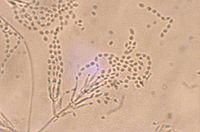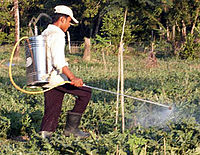
Application methods of Steinernema feltiae, Xenorhabdus bovienii and Purpureocillium lilacinum to control root-knot nematodes in greenhouse tomato systems
Sign Up to like & getrecommendations! Published in 2018 at "Crop Protection"
DOI: 10.1016/j.cropro.2018.02.009
Abstract: Abstract The efficacy of various biological control agents and their application methods was tested against the root-knot nematodes Meloidogyne javanica and Meloidogyne incognita in large, in-ground tomato production areas. Treatments included infective juveniles (IJs) of… read more here.
Keywords: lilacinum; application; control; root knot ... See more keywords

In vitro characterization bioassays of the nematophagous fungus Purpureocillium lilacinum: Evaluation on growth, extracellular enzymes, mycotoxins and survival in the surrounding agroecosystem of tomato.
Sign Up to like & getrecommendations! Published in 2022 at "Fungal biology"
DOI: 10.1016/j.funbio.2022.02.001
Abstract: The effects of water stress and temperature on in vitro growth and enzymatic activity of Purpureocillium lilacinum (Sordariomycetes, Hypocreales, Ophiocordycipitaceae) isolates with demonstrated capacity to control Nacobbus aberrans (Secernentea, Tylenchida, Pratylenchidae) were evaluated in this study.… read more here.
Keywords: lilacinum; characterization bioassays; purpureocillium lilacinum; growth ... See more keywords

Isaria macroscyticola, a rare entomopathogenic species on Cydnidae (Hemiptera), is a synnematous form and synonym of Purpureocillium lilacinum (Ophiocordycipitaceae)
Sign Up to like & getrecommendations! Published in 2020 at "Mycoscience"
DOI: 10.1016/j.myc.2020.03.002
Abstract: Abstract Isaria macroscyticola is a hypocrealean pathogen of Cydnidae first described by Dr. Yosio Kobayasi in 1941. Since then, records of this species have been limited, and therefore no cultures have been established and its… read more here.
Keywords: isaria macroscyticola; macroscyticola; lilacinum; form synonym ... See more keywords

The optimal concentrations of Purpureocillium lilacinum and jasmonic acid in controlling Meloidogyn javanica on tomato
Sign Up to like & getrecommendations! Published in 2019 at "Archives of Phytopathology and Plant Protection"
DOI: 10.1080/03235408.2018.1557375
Abstract: Abstract Management of root-knot nematodes (Meloidogyne spp.) is too difficult and is mainly based on chemicals. Synthetic nematicides contaminate the environment and endanger the human health, so scientists have been tried to find a new… read more here.
Keywords: jasmonic acid; javanica tomato; tomato; purpureocillium lilacinum ... See more keywords

Virulence of the Bio-Control Fungus Purpureocillium lilacinum Against Myzus persicae (Hemiptera: Aphididae) and Spodoptera frugiperda (Lepidoptera: Noctuidae).
Sign Up to like & getrecommendations! Published in 2022 at "Journal of economic entomology"
DOI: 10.1093/jee/toab270
Abstract: Eco-friendly entomopathogenic fungi are widely used to control agricultural insect pests. Purpureocillium lilacinum (Thom.) Luangsa-ard et al. (Hypocreales: Ophiocordycipitaceae) is a nematophagous fungus used for the bio-control of destructive root-knot nematodes. However, its insecticidal activities… read more here.
Keywords: lilacinum; hemiptera aphididae; myzus persicae; purpureocillium lilacinum ... See more keywords

Understanding the Transcriptional Changes During Infection of Meloidogyne incognita Eggs by the Egg-Parasitic Fungus Purpureocillium lilacinum
Sign Up to like & getrecommendations! Published in 2021 at "Frontiers in Microbiology"
DOI: 10.3389/fmicb.2021.617710
Abstract: The egg-pathogenic fungus Purpureocillium lilacinum parasitizes on nematode eggs, and thus, it is used as a good biocontrol agent against plant root-knot nematodes. However, little is known about the transcriptional response of P. lilacinum while… read more here.
Keywords: meloidogyne incognita; purpureocillium lilacinum; incognita eggs; fungus purpureocillium ... See more keywords

Search for Effective Approaches to Fight Microorganisms Causing High Losses in Agriculture: Application of P. lilacinum Metabolites and Mycosynthesised Silver Nanoparticles
Sign Up to like & getrecommendations! Published in 2022 at "Biomolecules"
DOI: 10.3390/biom12020174
Abstract: The manuscript presents the first report to produce silver nanoparticles (AgNPs) using soil-inhabiting Purpureocillium lilacinum fungus cell filtrate as a promising fungicide and nematicide on two microorganisms causing high economic losses in agriculture. Methods: A… read more here.
Keywords: application; causing high; losses agriculture; lilacinum ... See more keywords